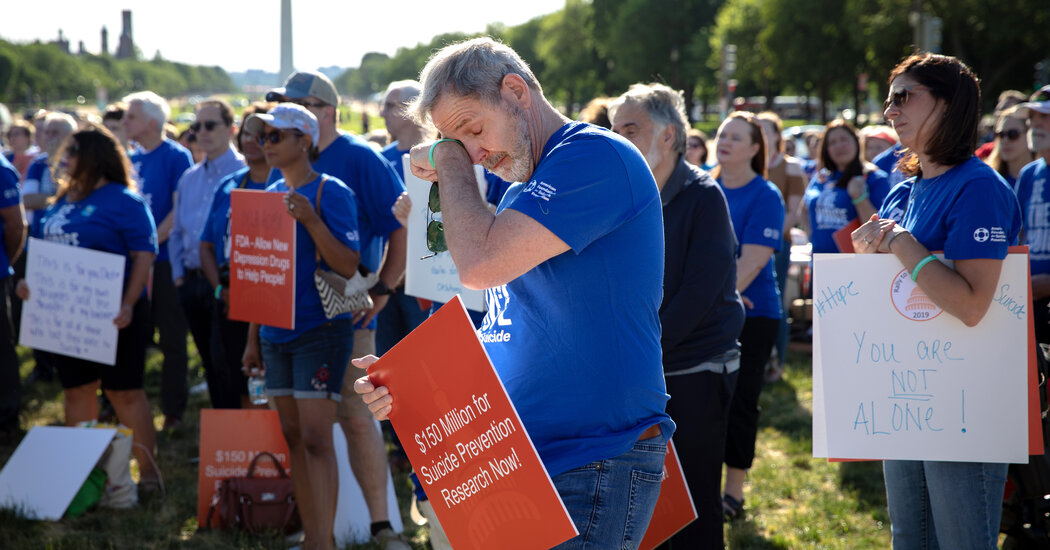The number of people who try suicide has risen steadily in the U.S. But despite gains in health coverage, nearly half are not getting mental health treatment.
Suicide attempts in the United States showed a “substantial and alarming increase” over the last decade, but one number remained the same, a new study has found: Year in and year out, about 40 percent of people who had recently tried suicide said they were not receiving mental health services.
The study, published in JAMA Psychiatry on Wednesday, traces a rise in the incidence of suicide attempts, defined as “self-reported attempts to kill one’s self in the last 12 months,” from 2008 to 2019. During that period, the incidence rose to 564 in every 100,000 adults from 481.
The researchers drew on data from 484,732 responses to the federal government’s annual National Survey on Drug Use and Health, which includes people who lack insurance and have little contact with the health care system. Because the data is self-reported, it could reflect faulty or inexact recollections.
They found the largest increase in suicide attempts among women; young adults between 18 and 25; unmarried people; people with less education; and people who regularly use substances like alcohol or cannabis. Only one group, adults 50 to 64 years old, saw a significant decrease in suicide attempts during that time.
Among the major findings was that there was no significant change in the use of mental health services by people who had tried suicide, despite the passage of the Affordable Care Act in 2010 and receding stigma around mental health care.
Over the 11-year period, a steady rate of about 40 percent of people who tried suicide in the previous year said they were not receiving mental health care, said Greg Rhee, an assistant professor of psychiatry at the Yale School of Medicine and one of the authors of the study.
The Affordable Care Act, which took effect fully in 2014, required all health plans to cover mental health and substance abuse services, and also sharply reduced the number of uninsured people in the U.S. In 2008, 43.8 million Americans, or 14.7 percent of the population, were uninsured, according to the Centers for Disease Control and Prevention. By 2020, the total uninsured had fallen to 28 million, or 8.6 percent of the population, the Census Bureau reported.
Still, many respondents to the survey in the new report said the cost of mental health care was prohibitive; others said they were uncertain where to go for treatment or had no transportation.
“It is a huge public health problem,” Dr. Rhee said. “We know that mental health care in the U.S. is really fragmented and complicated, and we also know not everybody has equal access to mental health care. So, it’s somewhat not surprising.”
Since people who try suicide have a higher likelihood of making another attempt in the next six months compared with the general population, the barriers to treatment are particularly troubling, he said.
“That is our idea of hope,” he said. “That is the goal of the medical structure. We want to provide health care to people who attempt suicidal behavior.”
Suicide is one of the top 10 leading causes of death in the United States, with a yearly death toll that has risen 60 percent in recent decades, to 48,344 in 2018 from 29,180 in 1999. During that period, the rate of suicide in the population increased by 35 percent, dipping for the first time, by 2 percent, in 2019, according to the C.D.C.
This has happened despite significant advances in brain science and the development of promising interventions using cognitive behavioral therapy, attachment-based family therapy and dialectical behavioral therapy, said Dr. Christine Moutier, the chief medical officer for the American Foundation for Suicide Prevention.
“One would argue, why haven’t the rates been going down?” she said. “Until 2018, it’s very clear that those have yet to be made accessible to the general population.”
The study suggests that overall, people who attempt suicide face especially high barriers to access, since the U.S. population as a whole is using mental health services at a higher level than ever before, with recent research suggesting that one in four Americans was receiving some care, Dr. Moutier said.
“This is not a new finding, from that standpoint, but it is terribly concerning,” said Dr. Moutier, who was not involved in the study.
The population of people who have tried suicide is distinct, demographically, from those who have died by suicide: While women make up a majority of suicide attempts, more than three-quarters of those who die by suicide are men, the data shows, among other reasons because men are more likely to use guns.
People who survive a suicide attempt often do well afterward, said Dr. Paul Nestadt, an assistant professor of psychology at Johns Hopkins who has researched the epidemiology of suicide.
He cited a 1978 study of 515 people who had tried suicide at the Golden Gate Bridge in San Francisco; after following up with the survivors for 26 years, researchers found 94 percent of them were alive or had died of natural causes, and only 4.9 percent had died by suicide subsequently.
Dr. Nestadt, who was not involved in the study, said the new data points, once again, to the scarcity of psychiatric beds or mental health professionals who take insurance, factors that have prevented medical science from bringing down the country’s suicide rates.
“The bottom line is, our treatments really work, that’s one of the things that always surprises medical students doing psychiatry rotations,” he said. “But people have to be able to access care. When they can’t, they’re left with less choices.”


























